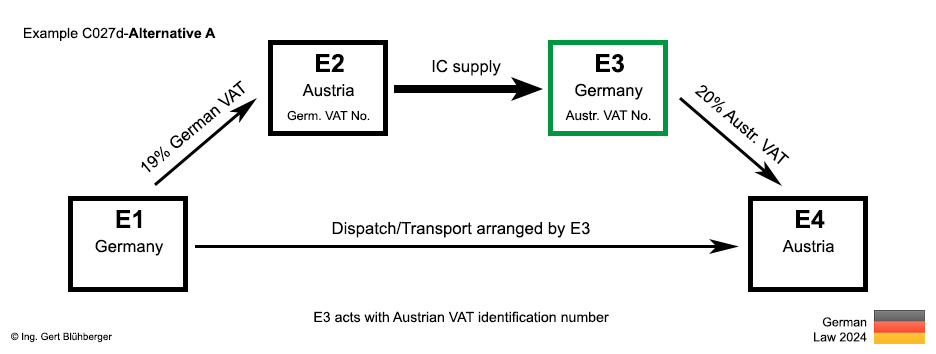Facts:
An Austrian entrepreneur E4 (= last purchaser) orders a machine from his German supplier E3 (=2nd purchaser). The latter in turn orders the machine from the Austrian wholesaler E2 (=1st purchaser). Since the wholesaler E2 does not have the machine in stock, he orders it from the German manufacturer E1 (= first supplier).
The German entrepreneur E3 instructs his forwarder with the pickup of the machine from the German manufacturer E1 and subsequent delivery to the Austrian entrepreneur E4. The German entrepreneur E3 (=intermediary operator) acts with his (German) VAT identification number and he communicates it to the Austrian wholesaler E2 in writing in the order document at the latest until the beginning of the shipment. Brief description of the chain transaction:
- Registration obligations:
- The Austrian entrepreneur E2 has to obtain a VAT registration in the country of departure (Germany).
- "Supply 1" from E1 (Germany) to E2 (Austria)
- Transaction without transport/dispatch assignment (§ 3 (7) UStG)
- Taxable supply in Germany (E1)
- "Supply 2" from E2 (Austria) to E3 (Germany)
- Transaction without transport/dispatch assignment (§ 3 (7) UStG)
- Taxable supply in Germany (E1)
- "Supply 3" from E3 (Germany) to E4 (Austria)
- Special feature of this chain transaction
- Since the German entrepreneur E3 acts with his German VAT identification number towards the Austrian entrepreneur E2, the provision of the § 3 (6a) UStG (Article 36a (2) of the Directive 2006/112/EC) applies. As a result, the tax exempt supply shifts to the supply between E3 and E4 and the German entrepreneur E3 does not have to register in the destination country Austria.
Detailed description from the perspective of the individual entrepreneurs: From the perspective of the 1st supplier E1 (from Germany): From the perspective of the 1st supplier E1 (from Germany):
Outgoing Invoice:
- Invoicing:
This supply is taxable in Germany (E1). The invoice must therefore be issued with 19 % German VAT, stating the own (German) VAT identification number.
- VAT Return:
Declaration of the sales transaction in line 13/code 81 as taxable (domestic) supply.
 From the perspective of the 1st purchaser E2 (from Austria): From the perspective of the 1st purchaser E2 (from Austria):
Registration obligations:- The Austrian entrepreneur E2 has to obtain a VAT registration in the country of departure (Germany) and act with his German VAT identification number towards E1 and E3. The entries listed below are consequently to be included in the German VAT return.
Incoming Invoice:
- VAT return (at the German Tax Office):
The German VAT contained in the incoming invoice can be deducted as input tax and must be included in the VAT return in line 38/code 66.
Outgoing Invoice:
- Invoicing:
This supply is taxable in Germany (E1). The invoice must therefore be issued with 19 % German VAT and specification of the own German VAT identification number.
- VAT Return (at the German Tax Office):
Declaration of the sales transaction as a taxable (domestic) supply in line 13/code 81 and payment of the VAT from this supply to the German Tax Office.
 From the perspective of the 2nd purchaser E3 (from Germany): From the perspective of the 2nd purchaser E3 (from Germany):
Incoming Invoice:
- VAT return:
The German VAT contained in the incoming invoice can be deducted as input tax and must be included in the VAT return in line 38/code 66.
Outgoing Invoice:
- Invoicing:
Invoice without VAT with reference to the tax exemption (intra-Community supply) pursuant to § 4 (1)(b) UStG in conjunction with § 6a UStG (or alternatively with reference to Article 138 of the Directive 2006/112/EC) and specification of the own (German) VAT identification number as well as the (Austrian) VAT identification number of the Austrian entrepreneur E4.
- VAT Return:
Declaration of the sales transaction as an intra-Community supply in line 19/code 41.
- EC Sales List (ESL / Recapitulative statement):
Declaration as an (intra-Community) supply to the (Austrian) VAT identification number of the Austrian entrepreneur E4.
- Intrastat Supplementary Declaration (Intrastat SD):
Declaration as dispatch to Austria. Since 2022, the country of origin and the (Austrian) VAT identification number of the Austrian entrepreneur E4 must also be reported.
 From the perspective of the last purchaser E4 (from Austria): From the perspective of the last purchaser E4 (from Austria):
Incoming Invoice:
- VAT return:
The incoming invoice contains no VAT and is to be included as an intra-Community acquisition in the VAT return. Therefore, on the one hand, the VAT (acquisition tax) must be paid and, on the other hand, it can be treated as input tax on the same return.
- Intrastat Supplementary Declaration (Intrastat SD):
Declaration as arrival from Germany.
Notes to the chain transaction:
- The above detailed description from the perspective of entrepreneur E4 represents only an indication of how the tax assessment would be if the German laws were to apply in Austria. National deviations from the German legislation were also not taken into account in the chain transaction sketch and the brief description!
- You can find the German version in the reihengeschaeftrechner.de.
- The assessment of this chain transaction from the Austrian perspective you can find in the reihengeschaeftrechner.at.
- Alternative A: If the German entrepreneur E3 acts with an Austrian VAT identification number towards the Austrian entrepreneur E2, the tax exempt supply shifts to the supply between E2 and E3. However, the supply from E3 to E4 is then taxable in Austria (20% Austr. VAT). The supply from E1 to E2 remains unchanged taxable in Germany.
- Alternative B: If the German entrepreneur E3 acts with a VAT identification number that is not from the country in which the chain transaction begins (Germany) or ends (Austria), the tax exempt supply tales place between E2 and E3 and therefore the simplification rules of the triangular transaction are applicable! The prerequisite for this is that the German entrepreneur E3 is not resident in the destination country Austria.
|



